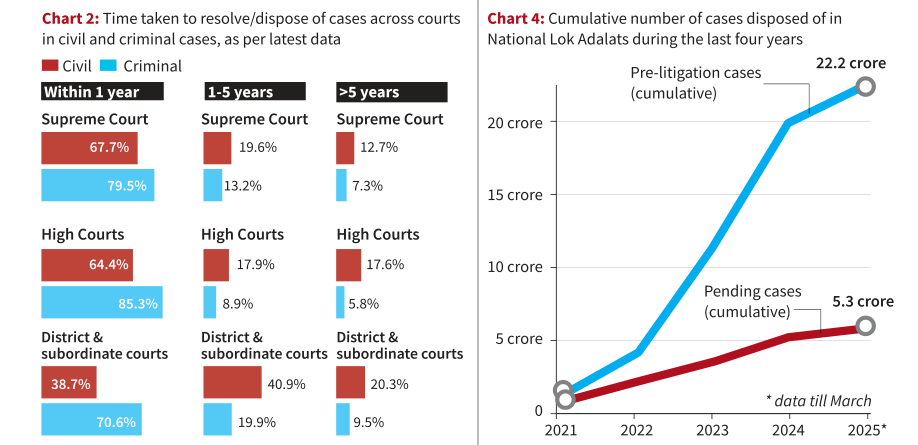PREVIOUS
Court cases in India 2025
July 31 , 2025
12 hrs 0 min
52
0
- In 2023, 86,700 cases are pending in the Supreme Court (SC).
- Over 65.3 lakh cases in High Courts (HCs), and 4.4 crore cases in district and subordinate courts (D&SCs) were pending.
- Last year, President Droupadi Murmu has criticised the 'dilatory litigation' that hampers justice delivery.
- Droupadi Murmu, in her address at the National Conference of District Judiciary, has coined the phrase ‘black coat syndrome’ to draw attention to the perennial problem of pendency in courts.
- She compared it to the ‘white coat syndrome’ patients feel in hospitals.
- The number of pending cases in India amounts to 5.1 crore cases.
- The Supreme Court has only 1,300 pending civil cases compared to the 20,400 criminal cases.
- Meanwhile, High Courts are facing an even greater disparity, with 68.3 per cent of their pending cases being civil cases.
- Similarly, the District and Subordinate Courts are facing an overwhelming 70 per cent of their pending cases as civil cases.
- This disparity underscores a systemic issue where civil cases, which often involve complex property, family or commercial disputes, exist at every level.
- HCs led by disposing of 85.3% criminal cases, followed by 80.9% by the SC, and 79.5% by district courts.
- However, when it comes to the civil litigation at the district courts, only 18.8% of pending cases were disposed of in 2023, where only 20% of new cases are added annually, and nearly 20% stretch beyond five years.
- Civil cases in district courts face the longest delays.
- It is exposing a stark mismatch between caseload and capacity.
- India's judicial functions are at 18,297, or 66.86%, of the 27,363 sanctioned posts.
- 9,065 posts are vacant, resulting in a 33% shortage.
- Vacant District and Subordinate Court posts, including those for civil litigation, have a sanctioned strength of 25,771 judges.
- It is averaging 18 judges per 10 lakh population.
- This is lower than China's 145 judges per 10 lakh population.
- To meet the judicial shortage, India needs to fill 9,065 vacant posts, which will help reduce the backlog.
- The Law Commission's recommendation of 50 judges per 10 lakh population has been largely ignored.
- But India operates with just 15 judges per 10 lakh population.
- The Lok Adalats, procedural reforms, alternative dispute resolution (ADR), and digitisation are effective ways forward to ease the burden on the judiciary.
- Lok Adalats provide quicker, more affordable, and accessible justice.
- Other alternatives, such as the mediation, arbitration, and conciliation, are more suitable for resolving disputes outside the traditional courtroom.
- The success of National Lok Adalats (NLAs) is demonstrated in all levels with 13.2 crore cases having been resolved till March 2024, compared to the pending 5.1 crore cases.
- The NLAs have resolved 3.34 crore civil cases and 1.96 crore criminal pre-litigation and 3.34 crore pending court cases.

Leave a Reply
Your Comment is awaiting moderation.


